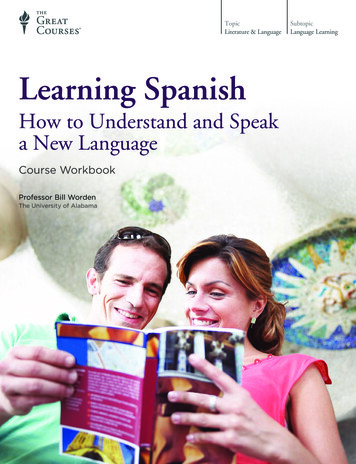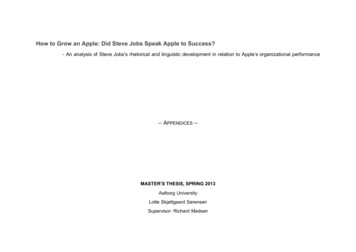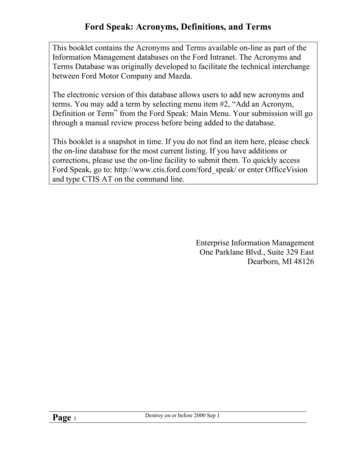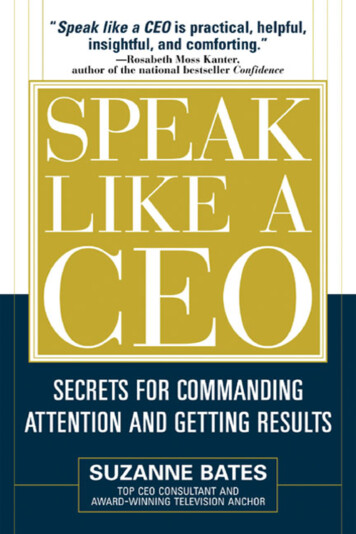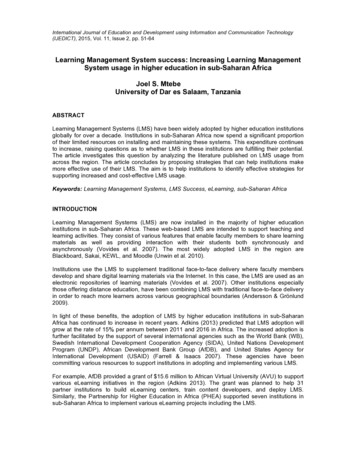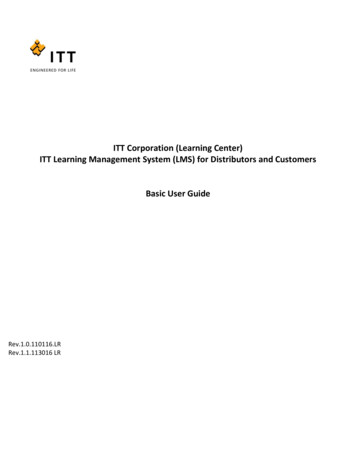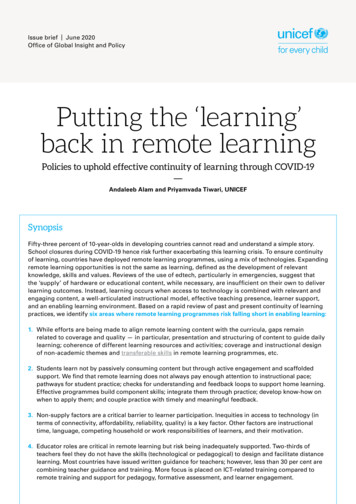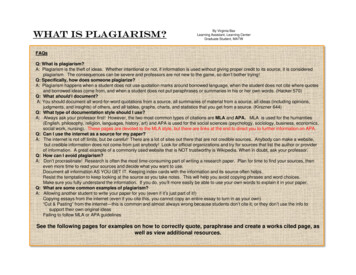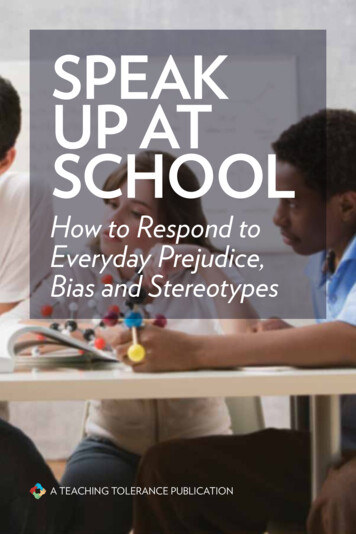
Transcription
SPEAKUP ATSCHOOLHow to Respond toEveryday Prejudice,Bias and StereotypesA TEACHING TOLERANCE PUBLICATION
SPEAKUP ATSCHOOLCONTENTSLetter from the Director . . . . . . . . . . . . . . . 3Introduction . . . . . . . . . . . . . . . . . . . . . . 4IN ADVANCEPrepare Yourself . . . . . . . . . . . . . . . . . . . . 8Prepare Your Students . . . . . . . . . . . . . . . . 12IN THE MOMENTBasic Strategies . . . . . . . . . . . . . . . . . . . . 18The Dynamic . . . . . . . . . . . . . . . . . . . . . .24The Location . . . . . . . . . . . . . . . . . . . . . .34Putting It into Words . . . . . . . . . . . . . . . . .42Putting It All Together . . . . . . . . . . . . . . . .44APPENDICESA. For Students . . . . . . . . . . . . . . . . . . . . .48B. Role-playing . . . . . . . . . . . . . . . . . . . . .49C. Changing School Policiesand Taking Action . . . . . . . . . . . . . . . . .54D. Resources . . . . . . . . . . . . . . . . . . . . . . 55Acknowledgements . . . . . . . . . . . . . . . . . . 56
Dear Educator,Many of the questions we receive for our magazine column “Ask Teaching Tolerance”are from educators seeking advice about how to respond when someone—a student, acolleague, even a parent—uses biased language or stereotypes in school.“IN THE END, WE WILLREMEMBER NOT THEWORDS OF OURENEMIES, BUT THESILENCE OF OURFRIENDS.”—MARTIN LUTHER KING JR.This booklet is our response. It’s for educators who want to develop the skills tospeak up themselves and who want to help their students find the courage to speakup too.What exactly is biased language, you might ask? Slurs, put-downs and othernegative labels, of course. We know these can start as early as kindergarten when,for instance, a boy is teased about being “girly” because he like dolls. And we’re alltoo familiar with the queasy feeling that comes when a colleague makes a joke thatrelies on stereotypes for its humor.No single word covers all this ground. In this guide, we refer to it as biasedlanguage, and to the larger problem as bias. We know that many, if not most, of theseremarks are said in ignorance, but that some reflect real hostility.This guide is for the adults in the school. It offers advice about how to respondto remarks made by students and by other adults and gives guidance for helpingstudents learn to speak up as well. We believe that modeling the kind of behaviorwe want from students is one of the most effective ways of teaching it.We also know that schools are hierarchies, for the adults and for the students.So we’ve addressed the ways responding to bias might be affected by the powerrelationship involved. It’s relatively easy for a teacher to correct a student who’sused an ethnic slur, but quite uncomfortable—even fearful—to do so when the slurcomes from a colleague, administrator or parent.Finally, you’ll notice that we talk a lot about “moments” in this guide. We’retalking about the very short time that passes when somebody says somethingand you struggle with how, or even whether, you’ll respond. These moments areopportunities that must be acted on swiftly. We hope this guide provides you withpractical ideas about how to respond to biased language in the moment, from anysource, in any situation.Maureen CostelloTeaching Tolerance Director23
THERE YOU ARE.IN THE CLASSROOM.IN THE CAFETERIA.ON A FIELD TRIP.You’re tongue-tied.Someone has said something biased that makes youuncomfortable, or even angry. You want to say something, butyou’re not sure what to say.It happens “almost daily,” one teacher relates. Maybe it’s one ofyour students. Or it’s a colleague. Or an administrator. And maybeyou laugh along—a forced or awkward laugh—because you don’twant to be rude. You see students grappling with the same issues.This guidebook offers tools and strategies to prepare you to speakup against prejudice, bias and stereotypes at school.Because whoever it is, and wherever you are, there are ways to be readyfor such moments, ways to make sure that you aren’t caught tonguetied, ways to make sure that you don’t let hate have the last word.NOTEThis is not an anti-bullying guidebook, though the strategies canbe used to address some forms of bullying behavior. If you areimplementing a specific anti-bullying curriculum in your school ordistrict, this guidebook can be used in concert with that effort.If, for example, you are using the Olweus Bullying PreventionProgram, you can work with the “Circle of Bullying” chart anduse strategies in this guidebook to move “Possible Defenders” andeven “Disengaged Onlookers” to genuine “Defenders.”45
INADVANCE
PREPAREYOURSELFQuestions place a burden on the person who made the remark.When faced with having to explain a “joke” or support astereotype, people sometimes find themselves at a loss. Followup with a simple “Tell me more” to help the person move towarda deeper understanding of why the remark is offensive. If thespeaker falls back on something such as, “C’mon, I was just beingfunny,” then you can use one of your ready responses, such as, “Idon’t find that funny.”Practice the phrases aloud. Memorize them. Have them readyfor the next moment.“The most important thing is to say something,” says DebNielsen, a middle school teacher in Durango, Colo. “Don’t let thesekinds of put-downs pass. Put yourself out there, and you will makea difference.”You’re an educator. You want to make the world a better place. Youwant to create a school environment that is safe and welcomingfor all students—and you don’t want to let moments of bias passsilently. But what to say?The best way to avoid being stymied when the moment occursis to prepare. Simply telling yourself that you are someone whowill speak up goes a long way toward shifting from inaction toaction. So say to yourself: I am a person who will speak up against bigotry. I will not let hate have the last word.A next step is to develop ready responses that will work in avariety of moments. That offends me. I don’t find that funny. I’m surprised to hear you say that.These phrases allow you to speak up against bias in a simple,straightforward manner. Sometimes they may open a dialogue.Other times, they simply allow you to challenge bias and take avocal stand against it.Simple questions also are a good way to interrupt everyday bigotry. What do you mean by that? Why would you say something like that? What point are you trying to make by saying that?8In AdvanceNielsen offers her own set of standard responses: Did you mean to say something hurtful when you said that? Using that word as a put-down offends me. Using that word doesn’t help others feel safe or accepted here.Keep these in mind as well:How do you say it? You know you’ll speak up. But what abouttone and temperament? Veteran educators say it’s best if youremain calm and thoughtful. Don’t react with shock. Mostly, justIn Advance9
be yourself. Be firm. Be confident. Know that you are doing theright thing. There is no need to shame or humiliate the otherperson; that tack too often works against you, galvanizing thebehavior instead of changing it. Humor is risky. Sometimes it candefuse a tense situation. Other times, though, it can send a mixedmessage. Was something about the bigoted comment funny? Areyou laughing at (and potentially shaming) the speaker, and willthat backfire?Assess the risk of speaking up. You may be branded toosensitive, too “politically correct,” too something. You may feel thesting of rejection. You may fear retaliation by hostile students orcolleagues. This is especially true when challenging someone inauthority. So consider your safety in any moment when you maychoose to speak up. Is now the best time? Could I handle this in adifferent way, later, that would be safer? Is there someone I trust—acolleague, a peer, a mentor—to whom I can speak about this, to helpme prepare for the next time it happens? Try not to let unwarrantedfear silence you, but do consider the consequences of speakingup—and weigh them against the consequences of not speaking up.Understand the dynamics of change. It happens slowly, andsometimes not at all. People can hold on to prejudice with tenacity.But know this: Speaking up offers a powerful force for good, andit is felt by all within earshot. If you speak up, others may follow—and others after them. You may inspire people to find the courageto speak up themselves, in a later moment. Don’t gauge successsolely by whether the person you are addressing changes; change“BE FIRM. BE CONFIDENT.KNOW THAT YOU AREDOING THE RIGHT THING.”Calling someone a “racist” may feel satisfying, but it also mayreinforce that person’s bigotry, and be counterproductive. Youmay never change this person’s behavior—a tough realization inanti-bias work—but that doesn’t mean you should strengthen theircause by behaving badly yourself. “I’m not going to call anotherteacher racist,” says Tracy Oliver-Gary, an ap history teacher fromBurtonsville, Md. “That just throws up a brick wall, and anythingelse I say will be lost.” As the old saying goes, be the changeyou want to see—and impart this idea to your students as oftenas possible. Keep in mind, too, that your students struggle with thesame issues you do, and more.is happening all around you, and the ability to marginalize bias is asign of success.Don’t undermine your efforts. If changed behavior is what youare after, keep that goal in mind—and let it shape your response.10In AdvanceIn Advance11
PREPAREYOURSTUDENTSThis guide aims to help people in school settings handle momentsof everyday bias—when and how to speak up. But if all we dois speak up after the fact, we will forever be responding to theproblem. So, at the outset, we want to put in a plug for prevention.This work starts in preschool and kindergarten and carriesright on through to high school graduation. It also begins on orbefore day one of any school year, when you consider how to buildcommunity within your classroom and how to develop groundrules or guidelines for communication.Ask yourself, “What climate do I want in my classroom and myschool?” Then ask yourself, “What can I do to promote that kindof atmosphere?”Consider these ideas:Teachers who provide such language and context tell us thatit often spreads outward from the classroom, into the halls andcafeteria, where they overhear students using language developedin the classroom to speak up against intolerant remarks.CLASSROOM COMMUNITYSeasoned teachers tell us that classroom community is at the heartof anti-bias work. Help students build meaningful relationshipswithin the classroom, and they will be ready and able to speak upagainst intolerance for themselves.Develop ground rules for communication, with student input, atthe outset of the school year. Post the rules prominently, and usethem as a touchstone when an issue arises. By creating languagetogether (“We want everyone to feel safe in our classroom.”) whena put-down is heard, you have that language ready: “I’m bettingnot everyone feels safe in this classroom when you say somethinglike that, Marcus.”Teachers who do this work at the beginning of the school yearsay that it pays off all year long in improved classroom behavior.It pays off in other ways, too. Researchers have found thesingle best way to eliminate bias is by having students of differentraces, ethnicities, abilities and socioeconomic backgroundswork together on successful projects. So by creating classroomsin which that happens, you are doing the upstream work ofpreventing future incidents.LANGUAGE AND CONTEXTStudents at all grade levels need language and context to helpthem become people who speak up against bias.Share with them the ready responses from the previous chapter.Or, better yet, brainstorm to come up with a list of their own, thenkeep that list posted in the classroom. It’s something you can referto during the year.In age-appropriate ways, discuss why some words hurt.Building context (historical, psychological, literary and so on)around such words helps students better understand theirpower to hurt.12In AdvanceIn Advance13
MODELING BEHAVIOR FOR YOUR STUDENTSDan Rubin, a high school language arts teacher in Las Cruces,N.M., encourages teachers to respond quickly and unequivocallywhen a student seeks help with a moment of bias—especially onein which the student felt powerless to respond.Rubin shares an example from a time when he served as advisorto the Gay-Straight Alliance (gsa) at his high school.At the beginning of the year, he asked gsa members whetherthey had any issues or concerns to share. One student describeda moment that had occurred near the end of the previous schoolyear. He told Rubin that one of his teachers had pulled him asideas the class was leaving, when the room was nearly empty. Theteacher had told him, “I know a church that can help you withyour ‘situation.’”The student told Rubin that he felt stymied, uncertain how torespond, so he had said nothing.Rubin immediately informed the principal via email. Thenext morning, the principal sent out an all-staff email remindingteachers that it was against district policy to discriminate againstany student based on his or her sexual orientation. The text of thespecific policy was included in the email.The email concluded: “Let me give you fair warning—whateveryour views may be, telling a student this is absolutely STRICTLYprohibited in our educational setting.”Visit tolerance.org for a wide variety of exercises and lessons topromote classroom community at all grade levels.GETTING STUDENTS IN THE FRAME OF MINDStudents who want to speak up face the same issues that you confrontedas you prepared. When you encourage them to speak up, remember toππ tell them they can do it.ππ discuss the importance of tone and temperament.ππ consider their safety.ππ be patient and believe they can make a difference.ππ keep their eyes on the behavior.ππ avoid labeling people.14In AdvanceIn Advance15
IN THEMOMENT16In the MomentIn the Moment17
BASICSTRATEGIES01 INTERRUPTEducators from all grade levels and all parts of the countryemphasize this point: You must speak up against every biasedremark, every time it happens. Letting one go, then speakingup against the next one, sends an inconsistent message: thatsometimes bias is ok; other times it isn’t. Letting the first instancego without comment also sends the message to anyone withinearshot that it’s ok to say bigoted things.So interrupt it. Every time. In the moment. Without exception.“Stop what you’re doing—whatever you’re doing—and addressit,” says Soñia Galaviz, a fifth-grade teacher in Nampa, Idaho.So if Galaviz is teaching a math lesson and she hears a studentmake a biased remark, what does she do? “I say to myself, ‘Holdon, let’s stop.’ The parallelogram lesson can wait. And I go backto all the work we did the first two months of school, discussingclassroom culture and sharing our own cultural stories. I addressit in the moment. I never let it pass. Anytime you let it pass, it’s anopportunity missed.”Usually, such moments have stopped happening by mid-yearor earlier, based on that early work, Galaviz says. But once, manyyears ago, well into the second half of the school year, a studentcasually used the n-word in class. “I went ‘Errrrrrh. Hold on asecond.’ I tempered my own response, so I wasn’t angry or out ofcontrol. And I asked why in the world he would say such a thing.”In the end, Galaviz worked lunch hours and after school withthe student, having him write what turned out to be a 15-pagepaper on the origin and history of the n-word. It was a lesson thestudent didn’t forget. When he was in high school, he came back18In the Momentand thanked Galaviz for teaching him the negative power and uglyhistory of that word.These moments are rare, Galaviz says. But early, firmintervention sends the message that bias will not be tolerated.Nancy Brakke, a music educator in Tacoma, Wash., admires andencourages these “instant” responses. “No anger, no recriminations,no lecture—just a calm, straightforward ‘stop,’” she says.Connecticut teacher Christine Sipes describes just such amoment: “I was a new teacher on lunch duty, and a veteranteacher came up to me and said, ‘Have you heard the one about theItalian and the ?’ I immediately said, “I don’t like ethnic jokes.’”This may not stop every so-called joke; the person still may tellsuch “jokes” to others. But it begins to marginalize the behavior.The more often it is interrupted, the more likely it will be curtailed.02 QUESTIONAs mentioned in the opening chapter, asking simple, exploratoryquestions in response to bigoted remarks can be a powerful tool:“Why do you say that?” “What do you mean?” “Tell me more.”Galaviz, the fifth-grade teacher, also serves as an adjunct facultymember at Boise State University. One of her students, preparingto begin student teaching, said to Galaviz, “You can tell kids whosefamilies don’t have an education.”In the Moment19
As it turns out, Galaviz, who has multiple degrees and solideducational credentials, grew up in a lower-middle class family,the daughter of parents who had to drop out of school to beginworking. She didn’t immediately challenge her student’s comment.Instead, she said, “Tell me more. Tell me what you mean by that.”She says that approach accomplished two things. One, it led thespeaker to encounter his own blind spots or bits of ignorance, asshe teased out the reasons behind his thinking. Two, it helped herbetter understand his thinking and gave her more time to frameand tailor her response.Galaviz says that this doesn’t work if you pepper the speakerwith aggressive questions. “What exactly do you mean by that?”Aggressive questioning can be counterproductive, closing offcommunication rather than opening it. The gentle-but-clear “tellme more” approach extends the conversation rather than shuttingit down.Tone matters in these moments. Your goal is to understandthe roots of the speaker’s prejudices, then help add context andinformation to dispel them.Don’t think for a moment that we all don’t have some sort ofprejudices. “I call them the ‘uglies,’ and we have to acknowledgethe uglies within ourselves if we’re ever going to make lastingchange,” Galaviz says.Amber Makaiau is an ethnic studies teacher at Kailua HighSchool in Oahu, Hawaii. She recalls a moment when she faced the“uglies” in front of her students.Makaiau periodically checks in with students about classroomculture—what’s working, what’s not working, any issues to discuss.During one of these check-ins, a student asked Makaiau whyshe pushed the Filipino students to talk more during classroomdiscussions but did not similarly push the white students.“WE ARE THERE TOLEARN AS MUCH ASTHE STUDENTS ARE.”“I said, ‘Hmmmm,’ and it surprised me. They had a good point,”Makaiau says. “They got to see me work through this surprisingrealization right in front of them, and I was able to change mybehavior accordingly. Teachers need to be open to that. We arethere to learn as much as the students are.”03 EDUCATEHate isn’t behind all hateful speech. Sometimes ignoranceis at work, or lack of exposure to diverse populations. Othertimes, people simply don’t know the negative power behindcertain words or phrases. So a good first step in a moment ofbias—particularly if it’s the first time you’ve encountered it withsomeone—is to explain why the term or phrase is offensive.So if someone says, “That’s so lame” or calls someone a “bitch,”not knowing the discriminatory or sexist power behind thesewords, you can offer background and context to encourage theperson to choose a different expression.Barbara Hemann, an Iowa teacher who has multiple sclerosis,shares this example:My most obvious symptom is my foot dragging as I walk, creatinga limp. A student once said to me, ‘What’s with the gimp?’I don’t think the student meant to be disparaging in any way,so I sat down and told him that although I was not hurt by hiscomment, that many people who have a disability would be, and20In the MomentIn the Moment21
that he should always be respectful and use respectful languageif he was going to ask someone about a disability. I told him thatI welcomed questions, and I would always take time to answerthose questions.I think the student left with a lifetime skill.So unless you are dealing with a longstanding pattern ofbehavior, give the speaker the benefit of the doubt, and allowthat person to make a change. “Be kind,” Hemann says. “Nearlyeveryone is fighting a great battle.”It is not your “job” to educate everyone else about bias. Peopledo need to take responsibility for their own ignorance. Selfeducation—the realization that one lacks knowledge on a subjectand will seek it out on one’s own—is vital.That said, you are in a school, and education happens inschools. So it’s a natural fit to wrap education around moments ofbias or stereotyping.clothes were faded and frayed.“Another teacher pulled the group aside to discuss whatshe overheard, explaining to the students that what they weredoing was teasing, bullying and very hurtful toward their peers,regardless of whether it was to their faces or behind their backs,”D’Egidio says.Afterward, the second-grade teaching team collectively decidedto follow up with a community meeting of all second-graders.“During the meeting, we did not single out the students whohad done the teasing, but we brought up the issue of teasingsomeone about their clothing or something else about themthrough gossiping,” D’Egidio says.Teachers role-played different scenarios, showing how gossipcan be hurtful. Then they asked students for examples of moreconsiderate behavior.“The teachers reminded students that words can hurt, whetherthey are used in private, overheard or said directly to someone,”D’Egidio says. “We also highlighted the importance of beingan ally, the importance of speaking up against teasing, and theimportance of everyone working together in a community tocreate a safe, caring space for all.”04 ECHOIt’s powerful to be the first voice that interrupts bias. It’s alsopowerful on another level to be the second, third or fourth voiceto join in the interruption. In group settings, if someone has saidsomething biased, and not one but four people speak up, theechoing power of those voices can have a multiplying effect.As the echoing voice, you can reiterate the anti-bias message oryou can thank the first person for speaking up—or both!Consider this, from a high school teacher working withninth‑graders:Consider this moment, shared by Vanessa D’Egidio, a secondgrade teacher in New York City: A group of second-grade girlswas overheard on the playground, laughing and making negativecomments about classmates’ clothing. They found fault withclothing that wasn’t name brand and laughed at others whose22 In the MomentI overheard a side conversation where a student said, ‘That’sso gay.’ I was shocked. I thought that phrase was rarely used.(Maybe I just wasn’t aware.) Immediately, another girl in thegroup said that was a wrong thing to say. The first girl giggledand said she was just being funny. The second girl said it’s notfunny because it hurts people. I was impressed, so I jumped intothe conversation. I told her, ‘Thank you. I have a lot of respect foryou speaking up like that, and I totally agree with you.’In the Moment23
THEDYNAMICSPEAKING FROM01 AUTHORITYWhen you communicate from a position of authority, yourwords often carry more weight—and sometimes you cannotgauge whether the listener genuinely understands or simply isunwilling to talk back. If the response is silence, don’t assumethat your message has sunk in. Watch closely to see if behaviorschange, and be ready to speak up again—and again—if needed.From a position of authority, your words also affect peopleto curb slurs and to empower others to speak out against them.Imagine that same principal delivering a message against slurs at aschoolwide assembly. That’s another case in which speaking fromauthority can have a huge impact.Perhaps more important, if someone in authority does not speakup, it empowers a different sort of behavior. That lack of actiontells everyone within earshot that slurs are allowed in hallways,classrooms or the office.A teacher from upstate New York describes the rural, largelywhite community in which she lives, where casual and not-socasual bias sometimes is allowed to thrive. But it does not thrivein her classroom, where she has the authority to set the tone andspeak out. She states it flatly, and takes responsibility for the work:“I am the only person who can stop the bigotry in my classroom.”A teacher from another part of the country learned her lessonon this issue from moments when she did not speak up.I often just did not pay attention to hurtful comments or bigotedbehaviors. [Then] I began to make a personal connection to myown life and how bullying had impacted me as a youth. Bullyingand bigoted behaviors have so many layers and are presented inso many ways. This is when I realized that I was contributing tothe problem by not speaking up and speaking out.“I AM THE ONLYPERSON WHO CANSTOP THE BIGOTRY INMY CLASSROOM.”within earshot. If a principal hears a student in the hallway usinga casual sexist slur and she stops to tell the student that biasedlanguage is not tolerated at the school, others will hear an antibias message from the top. This can have a ripple effect—both24In the MomentIn the Moment25
Every week, she found herself in situations where she needed tospeak up against comments that were intolerant. The result?I discovered that the more I speak up, the more I hear [mystudents] speaking up, too. This is one of the ways we create thatsafe space around us, where our young people know that they areaccepted, appreciated and heard.02 SPEAKING TO A PEERThere is power in a peer relationship. When a friend or trustedcolleague tells you something, you often hear it more clearlythan if it comes from some other source. Peer relationships alsoare problematic. Explaining to another teacher why offensivelanguage should be avoided might result in a reply along the linesof “You’re not my boss.”So there are considerations to be made: H ow close are you to this peer? (Strong friendship, mild butpositive acquaintance, nothing more than “hello” in the hallway?) What is the nature of past interactions? (Happy but shallow,feelings of real affinity, some tension over other issues?) How does this person best receive communication? (Written,verbal, with humor, in group settings, as a quiet aside?)Weigh your response based on relevant factors. Some examples:TEACHER-TO-TEACHERAn early-childhood educator from Wisconsin had someone sheconsiders a good friend speak excitedly about some bargains hehad found at a neighborhood yard sale. She continues:He said quite conversationally that he had ‘Jewed down’ theowner. I asked what he meant and watched as his face went frompuzzlement (at my ‘ignorance’) to embarrassment (he knowsquite well that I’m Jewish). I let him flounder for a bit and thentossed him a lifeline—his promise not to use that phrase again,regardless of who is in the room.An elementary school principal in the Pacific Northwest saysthat he routinely interrupts when he hears biased words beingused—either with teachers or with students.I step in. I say, ‘Whoa, whoa, whoa.’ The vast majority, withstudents, is kids using words they don’t really understand. Theyjust know the word is negative, a put-down. So I make it public,but I don’t make it punitive. It’s a teachable moment, and I wanteveryone within earshot to know it’s not okay to speak thatway here.26In the MomentSTUDENT-TO-STUDENTA Georgia high school student describes himself as the onlyAfrican American in his circle of friends.They do not necessarily say mean-spirited things or bully medirectly, but they always make a point to mention that I am the‘token black.’ I usually laugh it off or ignore it, but recently itbecame too much. I was having a bad day, and I could not holdback my annoyed feelings any longer. I began to yell at themexplaining how racist it was that they called me that and howmean they were being. When I finally finished, they stared at meuntil one of the boys started laughing. They all laughed and madefun of me, and I realized that all I did was fuel their fire.In the Moment27
Looking back, the student says he would have changedhis approach.I would have confronted it much earlier, when I first realized that Ihad a problem with the way I was being treated. I should have pulledmy friends aside or talked to them individually, explaining my issueswith the situation—not with anger or revenge, but with calmness.“I SHOULD HAVEEXPLAINED MY ISSUESWITH THE SITUATION.”03 SPEAKING TO AUTHORITYSpeaking up to an authority figure is tricky. It carries risk. Areyou questioning your principal’s leadership skills? Or are youchallenging a senior teacher in a way that might backfire? Will youface punitive reactions? Is the power relationship so imbalancedthat you won’t be heard at all—or worse, will be mocked for beingoverly sensitive or “whiney”?I wrote a letter to my teachers and administrators at thebeginning of the school year, reminding them the power they haveto teach their students not only about academics but also socialvalues, such as respectful language. I was nervous. I wonderedthat their response would be.A few days after the letter arrived in all teachers’ mailboxes,Emma’s biology teacher stopped her in the hallway.He said, ‘I know there have been times I haven’t said anything.I am sorry, and I plan on calling out more students now.’ I wasspeechless. My teacher was coming up to me to apologize; Ithought students always did the apologies. I am honored tohave gone to a sch
students learn to speak up as well We believe that modeling the kind of behavior we want from students is one of the most effective ways of teaching it We also know that schools are hierarchies, for the adults and for the students So we’ve addressed t
